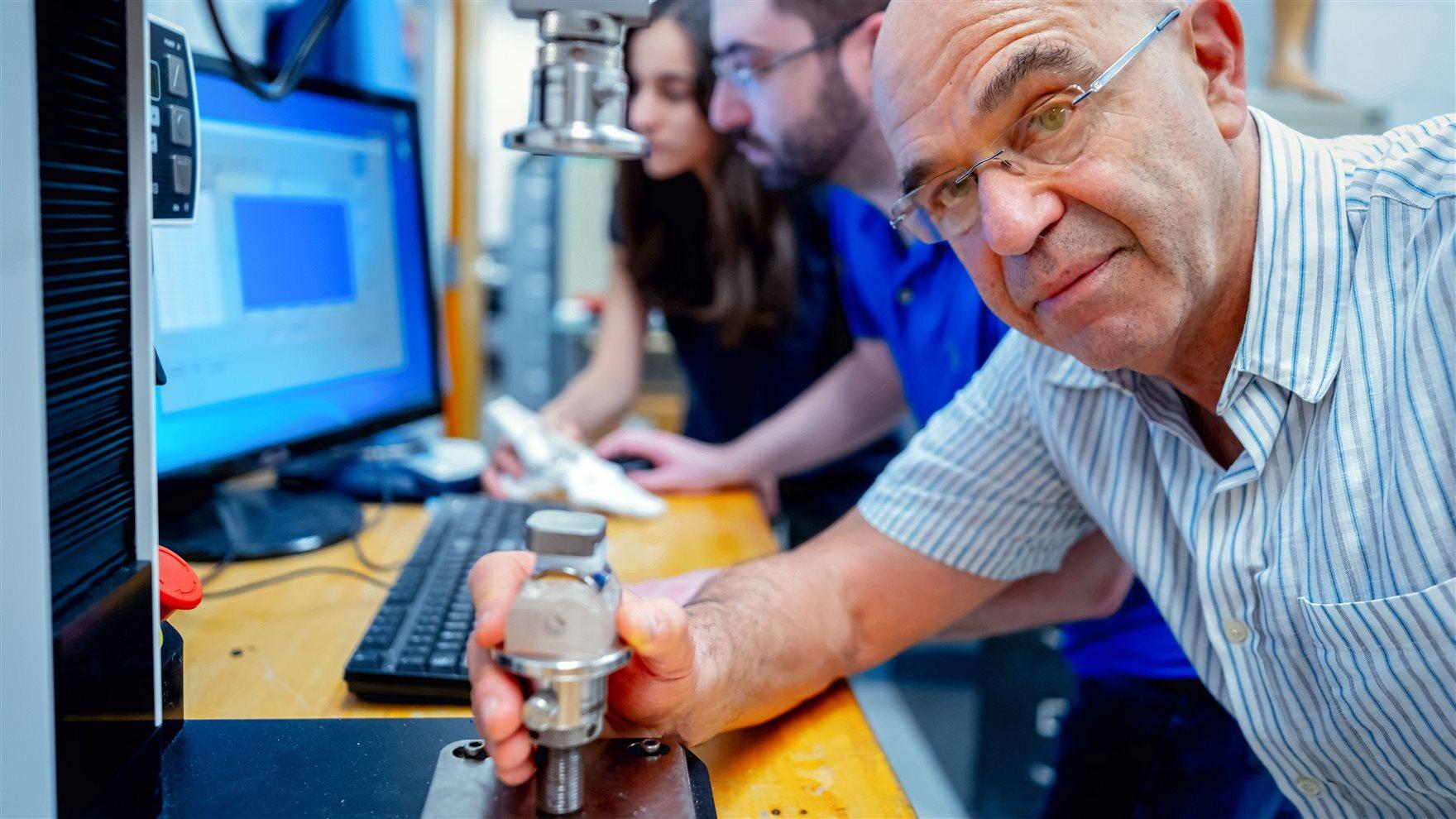Medical Device Firm Supports Doctoral Students’ Research

Drexel mechanical engineering doctoral students María Ruiz and Jordan Stolle, left to right in the background, are conducting research with Sorin Siegler, PhD, professor of mechanical engineering at the Drexel College of Engineering, who is holding a revolutionary ankle replacement implant for which he obtained a patent in 2018. Photo credit: Jeff Fusco.
Two Drexel University doctoral students are studying ways to improve a revolutionary ankle replacement implant patented by their professor.
María Ruiz and Jordan Stolle, both pursuing PhDs in mechanical engineering, are conducting research on the Kinos Axiom Total Ankle System, for which Sorin Siegler, PhD, professor of mechanical engineering at Drexel’s College of Engineering, obtained a patent in 2018.
Their research is being supported by restor3d, a medical device company based in Durham, North Carolina, which merged with Kinos Medical, a startup launched to commercialize implants based on Siegler’s work.
Siegler’s groundbreaking discovery corrected a misunderstanding of the shape of a bone in the ankle joint that had persisted in the medical community for 70 years, undermining the success of ankle replacement surgeries. Ankle replacements had proved so unreliable that many patients with arthritic or injured ankles opted to undergo fusions that robbed them of flexibility. Implants designed with Siegler’s insights about the complex anatomy of the ankle preserve a patient’s range of motion.
A chain of events quickly followed Siegler’s breakthrough, starting with the launch of Kinos Medical, which obtained FDA approval to begin implanting the artificial ankles. Then the company merged with restor3d, which seeks to improve medical devices by leveraging expertise in 3D printing of advanced biomedical materials, anatomic and kinematic modeling, and AI-based planning and design tools.
Ruiz and Stolle have distinct but overlapping roles in advancing the ankle implants that grew from Siegler’s invention.
Through computational modeling, Ruiz runs simulations that use scans taken by surgeons of their patients’ joints. The simulations replicate a foot’s movement, illustrating the angle of rotation as 14 bones in the ankle and foot reposition with each step.
“We are studying if the implant can move or behave as a normal joint would,” said Ruiz who will complete her PhD this summer. “We put it into critical positions to see if it can replicate an ankle joint without an implant.”
Stolle examines the interface between the bone and the implant, watching for stresses and deformations that may occur under different conditions.
“Each implant will have its own way it fixes the bone,” Stolle explained. “If we apply a certain force or torque to the implant put in a certain way, will it rip out? We’re trying to figure out what the response to those loading conditions is going to be for those interface positions.”
In Ruiz’s simulations, she applies loads to see what motion occurs. Stolle then stops her simulations in time - with a foot halfway through a rotation - to see if it will break. The process allows the researchers to challenge assumptions about how the joints will behave.
The team is also assessing the effect of wear on tear on the implants, which are constructed like a sandwich of two metal parts surrounding a plastic component in the middle.
The interface between metal and plastic mimics the frictionless behavior of a natural ankle joint, Stolle explained.
Yet, Ruiz noted, the plastic component in the middle could wear off, over time.
“We keep on trying to improve,” said Ruiz, adding that the research will serve her well when she launches her career in industry.
“Learning from the research done at the University was the best experience I could have asked for,” she said. “It was very exciting to see how research has helped in many design decisions for the implant. But restor3d as a company also showed us all the strict medical regulations that a medical device must follow, as well as taking into account surgeon preferences and manufacturing limitations.”
Keep up with enterprising research and other advances across the University by signing up to receive Drexel Innovates, a monthly eNewsletter.
In This Article
Drexel News is produced by
University Marketing and Communications.

